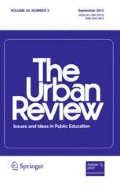Abstract
Community and school violence continue to be a major public health problem, especially among urban children and adolescents. Little research has focused on the effect of school safety and neighborhood violence on academic performance. This study examines the effect of the school and neighborhood climate on academic achievement among a population of 3rd–5th grade students in an urban public school system. Community and school safety were assessed using the School Climate Survey, an annual City-wide assessment of student’s perception of school and community safety. Community violence was measured using the Neighborhood Inventory for Environmental Typology, an objective observational assessment of neighborhood characteristics. Academic achievement was measured using the Maryland State Assessment (MSA), a standardized exam given to all Maryland 3rd–8th graders. School Climate Data and MSA data were aggregated by school and grade. Objective assessments of neighborhood environment and students’ self-reported school and neighborhood safety were both strongly associated with academic performance. Increasing neighborhood violence was associated with statistically significant decreases from 4.2 to 8.7% in math and reading achievement; increasing perceived safety was associated with significant increases in achievement from 16 to 22%. These preliminary findings highlight the adverse impact of perceived safety and community violence exposure on primary school children’s academic performance.

Similar content being viewed by others
References
Bowen, N. K., & Bowen, G. L. (1999). Effects of crime and violence in neighborhoods and schools on the school behavior and performance of adolescents. Journal of Adolescent Research, 14, 319–342.
Buka, S. L., Stichick, T. L., Birdthistle, I., & Earls, F. J. (2001). Youth exposure to violence: Prevalence, risks, and consequences. American Journal of Orthopsychiatry, 71, 298–310.
Coley, R. L., & Hoffman, L. W. (1996). Relations of parental supervision and monitoring to children’s functioning in various contexts: Moderating effects of families and neighborhoods. Journal of Applied Developmental Psychology, 17, 51–68.
Eitle, D., & Turner, R. J. (2002). Exposure to community violence and young adult crime: The effects of witnessing violence, traumatic victimization, and other stressful life events. The Journal of Research in Crime and Delinquency, 39, 214–237.
Furr-Holden, C. D. M., Smart, M. J., Pokorni, J. L., Ialongo, N. S., Leaf, P. J., Holder, H. D., et al. (2008). The NIfETy method for environmental assessment of neighborhood-level indicators of violence, alcohol, and other drug exposure. Prevention Science, 9, 245–255.
Garbarino, J., & Kostelny, K. (1997). What children can tell us about living in a war zone. In J. Osofsky (Ed.), Children in a Violent Society (pp. 32–42). New York: The Guilford Press.
Gorman-Smith, D., & Tolan, P. (1998). The role of exposure to community violence and developmental problems among inner-city youth. Development and Psychopathology, 10, 101–116.
Jenkins, E. J., & Bell, C. C. (1994). Violence among inner city high school students and posttraumatic stress disorder. In S. Friedman (Ed.), Anxiety disorders in African Americans (pp. 76–88). New York: Springer.
Scheier, L. M., Botvin, G. J., & Miller, N. L. (1999). Life events, neighborhood stress, psychosocial functioning, and alcohol use among urban minority youth. Journal of Child and Adolescent Substance Abuse, 9, 19–50.
Schwab-Stone, M. E., Ayers, T. S., Kasprow, W., Voyce, C., Barone, C., Shriver, T., et al. (1995). No safe haven: A study of violence exposure in an urban community. Journal of the American Academy of Child and Adolescent Psychiatry, 34, 1343–1352.
Selner-O’Hagan, M. B., Kindlon, D. J., Buka, S. L., Raudenbush, S. W., & Earls, F. J. (1998). Assessing exposure to violence in urban youth. Journal of Child Psychology, 39, 215–224.
Wright, R. J., Mitchell, H., Visness, C. M., Cohen, S., Stout, J., Evans, R., et al. (2004). Community violence and asthma morbidity: The inner-city asthma study. American Journal of Public Health, 94, 625–628.
Acknowledgments
This work was supported by National Institute of Mental Health 5T32MH019545-18, National Institute on Alcoholism and Alcohol Abuse 1R01AA015196, and Center for Disease Control & Prevention 1U49CE000728. City planning data was provided by the Baltimore City’s Mayor Office of Information and Technology. School Climate and Maryland State Assessment data was provided by the Baltimore City Public School System.
Author information
Authors and Affiliations
Corresponding author
Rights and permissions
About this article
Cite this article
Milam, A.J., Furr-Holden, C.D.M. & Leaf, P.J. Perceived School and Neighborhood Safety, Neighborhood Violence and Academic Achievement in Urban School Children. Urban Rev 42, 458–467 (2010). https://doi.org/10.1007/s11256-010-0165-7
Published:
Issue Date:
DOI: https://doi.org/10.1007/s11256-010-0165-7




